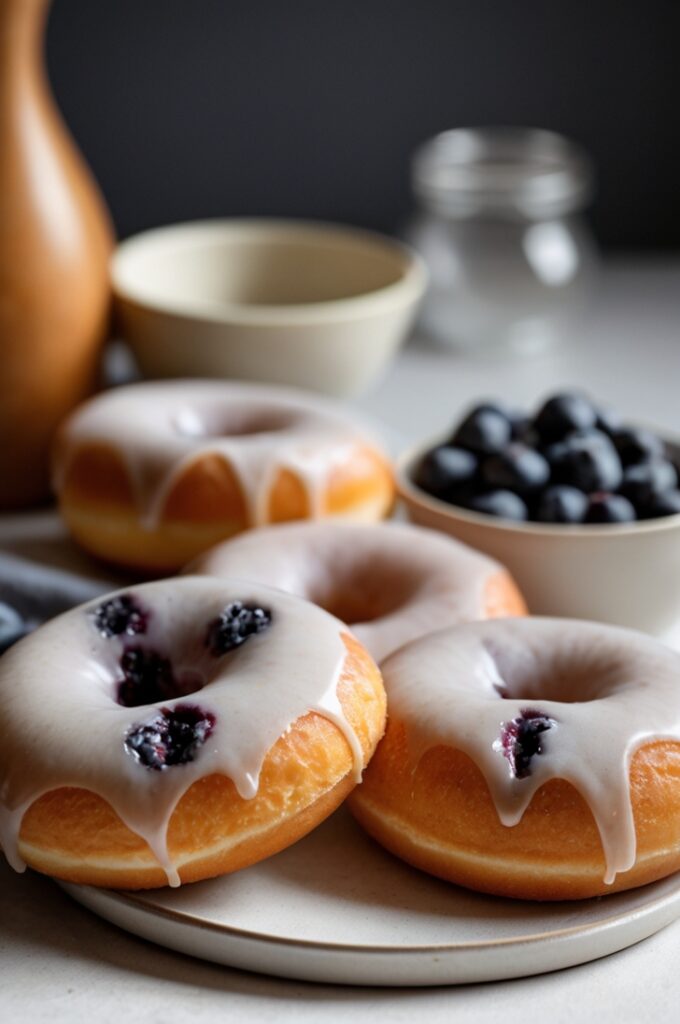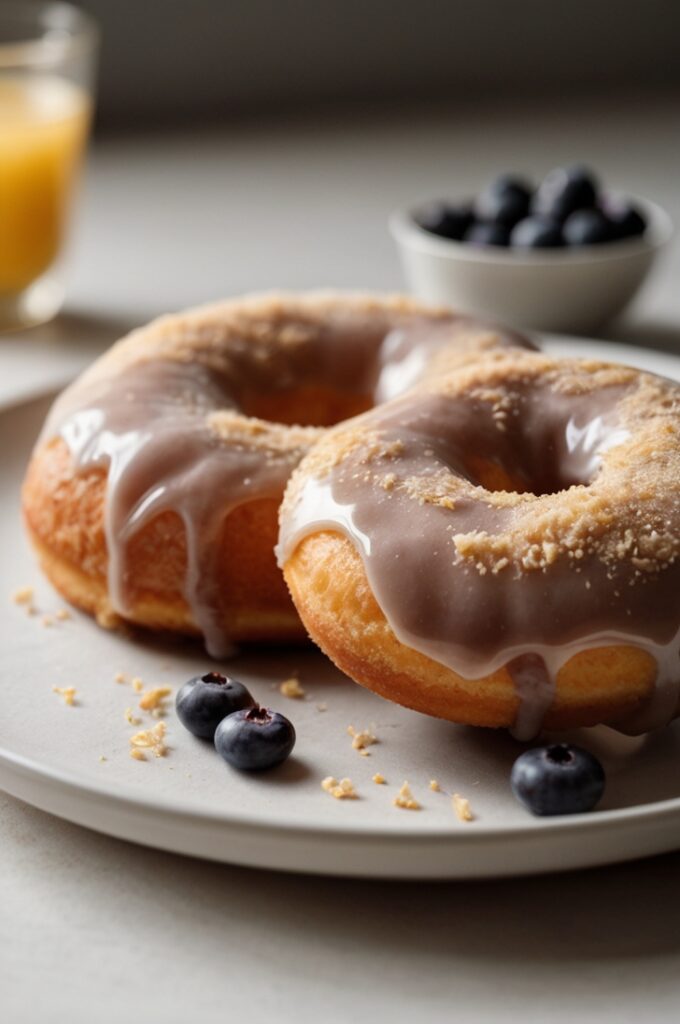My grandmother used to say that donuts were “morning’s perfect circle of happiness.” I’ve carried that wisdom through decades in professional kitchens, where the humble donut has taught me more about balanced flavors and textures than many so-called “sophisticated” desserts. Baked blueberry cake donuts, with their tender crumb and burst of fruit, represent donut perfection without the mess and hassle of deep-frying.
Ever wondered why some bakeries have lines around the block for their cake donuts? It’s because they’ve mastered what most home bakers miss—the delicate balance between moisture and structure that creates that distinctive “donut” identity rather than just circular cake. After testing literally hundreds of variations, I can finally share the professional secrets that’ll elevate your blueberry cake donuts from “nice try” to “where can I buy a dozen?”
Ingredients & Substitutions
For the Donuts:
- 2 cups all-purpose flour (240g)
- 2 teaspoons baking powder
- 1/2 teaspoon baking soda
- 3/4 teaspoon kosher salt (or 1/2 teaspoon table salt)
- 2 large eggs, room temperature
- 3/4 cup granulated sugar (150g)
- 1/3 cup vegetable oil (can substitute melted butter for richer flavor)
- 1/2 cup sour cream (120g)
- 1/4 cup whole milk (60ml)
- 2 teaspoons vanilla extract
- 1/4 teaspoon almond extract (optional but recommended)
- 1 1/2 cups fresh blueberries (or 1 cup dried blueberries, rehydrated)
- 1 tablespoon lemon zest (optional)
For the Glaze:
- 2 cups powdered sugar (240g)
- 3-4 tablespoons milk or heavy cream
- 1/2 teaspoon vanilla extract
- 1 tablespoon fresh lemon juice (optional for lemon glaze)
- 1 teaspoon blueberry powder (optional for color and flavor)
The flour choice here matters significantly. All-purpose gives the ideal structure, but cake flour creates a more delicate crumb—tho at the risk of donuts that fall apart too easily. For gluten-free options, a quality cup-for-cup blend with xanthan gum works surprisingly well, particularly when paired with an extra egg yolk for binding.
Sour cream is my professional secret for cake donuts. It provides acidity that activates the baking soda while adding richness without heaviness. Greek yogurt makes an excellent substitution, or for dairy-free versions, try coconut yogurt (which adds a subtle complementary flavor to the blueberries).
When it comes to blueberries, fresh wild berries deliver concentrated flavor in tiny packages, but they’re seasonal and expensive. Frozen berries work fine but must be kept frozen until the last moment to prevent bleeding. For year-round consistency, dried blueberries rehydrated in hot water for 15 minutes provide reliable flavor and texture without the risk of soggy batter.
Step-by-Step Instructions

Preparing the Batter
- Preheat your oven to 350°F (175°C) and generously grease two 6-cavity donut pans with non-stick spray or butter.
- In a medium bowl, whisk together the flour, baking powder, baking soda, and salt. Proper incorporation here prevents those unpleasant baking soda pockets that can ruin an otherwise perfect donut.
- In a large bowl, beat the eggs and sugar with an electric mixer until pale and thickened, about 2 minutes. This aeration creates initial structure that carries through to the final product.
- Add the oil in a slow, steady stream while mixing on low speed, then mix in the sour cream, milk, and extracts until just combined. Many home bakers overmix at this stage, activating too much gluten and resulting in tough donuts.
- Gently fold the dry ingredients into the wet ingredients using a spatula, stopping when a few streaks of flour remain visible. This under-mixing is deliberate and will be resolved in the next step.
- If using fresh blueberries, toss them with 1 tablespoon of your measured flour before folding them into the batter. This light coating helps them distribute evenly without sinking. Fold berries and lemon zest (if using) into the batter with just 3-4 strokes—overmixing will break the berries and turn your batter purple.
Baking the Donuts
- Transfer the batter to a piping bag or zip-top bag with a corner snipped off. This precision technique ensures even donut shapes and cleaner pans than the spoon method most recipes suggest.
- Pipe the batter into the prepared donut cavities, filling each about 3/4 full. Tap the pan firmly on the counter twice to release air bubbles and level the batter.
- Bake for 12-14 minutes until the tops spring back when lightly touched and a toothpick inserted comes out clean with a few moist crumbs. Don’t wait for golden brown—these donuts should remain relatively pale.
- Cool in the pan for precisely 5 minutes (not longer, or they’ll steam and become soggy), then gently transfer to a wire rack for complete cooling.
Glazing Techniques
- While the donuts cool, prepare your glaze by sifting the powdered sugar into a wide, shallow bowl. Sifting is non-negotiable for professional-quality glaze texture.
- Gradually whisk in milk or cream, vanilla, and any optional flavors until you reach a consistency that coats the back of a spoon but runs off slowly. Too thin, and the glaze disappars into the donut; too thick, and it’ll crack when bitten.
- When donuts are completely cool (or just barely warm), dip the tops into the glaze, allowing excess to drip off. For a thicker coating, wait 5 minutes for the first layer to set, then dip again.
- Return glazed donuts to the cooling rack to set, placing parchment paper underneath to catch drips. At room temperature, glaze will set in about 20 minutes; expedite this in the refrigerator if necessary.
Cooking Techniques & Science
The magic of cake donuts lies in their unique texture—lighter than pound cake but more substantial than a muffin. This specific texture profile comes from the proper balance of leavening agents. Baking powder provides most of the lift, while a smaller amount of baking soda reacts with the acidic ingredients (sour cream and blueberries) to create additional carbon dioxide bubbles that expand during baking.
Why baked rather than fried? Beyond the obvious health benefits, baking creates a more consistent donuts when fruit is involved. The intense heat of frying oil causes berries to rupture violently, often leading to structural collapse. Baking allows for gentler heat penetration and more even cooking around the fruit inclusions.
The batter’s relatively high proportion of fat (from oil and sour cream) serves multiple purposes. It coats flour proteins, limiting gluten development for tenderness, while also distributing heat evenly during baking. This fat content also extends shelf life by slowing moisture loss—these donuts will stay fresh for 36 hours when properly stored.
Using a combination of oil and sour cream rather than butter provides superior moisture retention. Butter contains water that evaporates during baking, while oil is 100% fat, resulting in donuts that stay moist longer. The sour cream’s proteins also bind water molecules, further enhancing moisture retention.
Temperature control is crucial for blueberry incorporation. Room-temperature batter helps fresh berries maintain integrity, while cold batter works better with frozen berries to prevent color bleeding. For maximum flavor extraction without compromising structure, crushing about 1/4 of the blueberries slightly before folding in releases more aromatic compounds throughout the batter.
Serving & Pairing Suggestions
Freshly glazed blueberry cake donuts deserve thoughtful presentation. For casual settings, stack them pyramid-style on a rustic wooden board with fresh blueberries and mint leaves scattered around. For more elegant service, place individual donuts on small white plates with a light dusting of blueberry powder and a delicate drizzle of lemon-infused honey.

These donuts reach their flavor peak about 30 minutes after glazing, when the exterior has set but the interior maintains peak moisture. After that, flavor compounds continue developing for several hours, though textural quality gradually diminishes.
Pair these blueberry donuts with beverages that complement rather than compete. A cortado or flat white coffee provides balanced bitterness that cuts through the sweetness. For non-coffee drinkers, an Earl Grey tea with bergamot notes creates surprising flavor harmony with the blueberries. In summer months, a sparkling elderflower water offers refreshing contrast.
For brunch service, these donuts work beautifully alongside savory egg dishes, particularly those featuring herbs like thyme or tarragon that share molecular flavor compounds with blueberries. The contrast of sweet donuts with savory proteins creates memorable flavor experiences that will have guests talking.
Transform these donuts into a legitimate dessert by warming slightly and serving with mascarpone whipped cream and a compote of mixed berries. The cake donut’s sturdy structure allows it to absorb some of the compote’s juices without disintegrating, creating textural complexity that elevates it beyond simple breakfast fare.
Conclusion
Mastering baked blueberry cake donuts represents the intersection of scientific understanding and artistic execution. The techniques described here—from the specific ratio of leavening agents to the precise folding method for berry incorporation—stem from both classical bakery tradition and modern culinary science.
The most common pitfall remains overmixing. When you think you’ve folded enough, stop. The final folds should happen as the batter hits the pan. Remember also that these donuts will not brown significantly; rely on touch and toothpick tests rather than color for doneness assessment.
Consider these donuts not just as a recipe but as a template for seasonal adaptation. The blueberries can be substituted with any firm berry or diced stone fruit throughout the year. The core batter, with its perfect balance of tenderness and structure, provides an exceptional canvas for creative exploration.
FAQs
Why did my blueberries sink to the bottom of the donuts?
Sinking berries typically result from either too thin a batter or berries that are too heavy. Make sure your batter maintains proper thickness by measuring flour carefully (preferably by weight), and consider using wild blueberries which are smaller and distribute more evenly. Coating berries with flour before folding in also helps them “float” in the batter during baking.
Can I make these donuts without a special donut pan?
While donut pans create the iconic shape, this batter works exceptionally well in mini bundt pans for “donut cakes” or even in muffin tins for “donut muffins.” Adjust baking time accordingly—add about 4-5 minutes for muffins. For traditional donut pans, invest in quality ones with good non-stick coating; cheaper pans often result in stuck, torn donuts.
My glaze hardened before I could dip all the donuts. What went wrong?
Glaze crystallization happens when it’s exposed to air too long or when there’s too much powdered sugar relative to liquid. Keep your glaze workable by placing the bowl over another bowl containing warm (not hot) water, which maintains appropriate temperature. If it still thickens, whisk in additional liquid 1/2 teaspoon at a time until proper consistency returns.
How can I get a more intense blueberry flavor?
For maximum blueberry impact, use a combination approach: fresh berries in the batter, plus 2 tablespoons of freeze-dried blueberry powder (ground in a spice grinder) added to the dry ingredients. This provides both juicy berry pockets and concentrated flavor throughout. Alternatively, reduce 1 cup of blueberries with 2 tablespoons of sugar to make a quick compote, then cool completely before swirling through the finished batter just before baking.
Can I freeze these donuts?
These donuts freeze remarkably well before glazing. Cool completely, wrap individually in plastic wrap, then place in a zip-top freezer bag for up to 3 months. Thaw at room temperature and glaze fresh on the day of serving. Pre-glazed donuts can be frozen but the glaze texture suffers slightly upon thawing.

